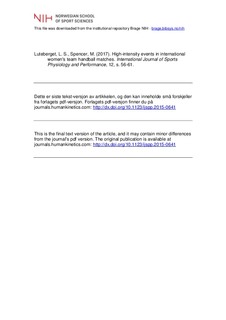| dc.contributor.author | Luteberget, Live | |
| dc.contributor.author | Spencer, Matt | |
| dc.date.accessioned | 2017-04-19T12:49:58Z | |
| dc.date.available | 2017-04-19T12:49:58Z | |
| dc.date.issued | 2017-01 | |
| dc.identifier.citation | International Journal of Sports Physiology and Performance. 2017, 12, 56-61 | nb_NO |
| dc.identifier.uri | http://hdl.handle.net/11250/2438434 | |
| dc.description | I Brage finner du siste tekst-versjon av artikkelen, og den kan inneholde ubetydelige forskjeller fra forlagets pdf-versjon. Forlagets pdf-versjon finner du på journals.humankinetics.com / In Brage you'll find the final text version of the article, and it may contain insignificant differences from the journal's pdf version. The definitive version is available at journals.humankinetics.com | nb_NO |
| dc.description.abstract | Purpose: International women’s team handball is a physically demanding sport and is intermittent in nature. The aim of the study was to profile high-intensity events (HIEs) in international women’s team handball matches with regard to playing positions. Methods: Twenty female national-team handball players were equipped with inertial movement units (OptimEye S5, Catapult Sports, Australia) in 9 official international matches. Players were categorized in 4 different playing positions: backs, wings, pivots, and goalkeepers (GKs). PlayerLoad™, accelerations (Acc), changes of direction (CoD), decelerations (Dec), and the sum of the latter 3, HIEs, were extracted from raw-data files using the manufacturer’s software. All Acc, Dec, CoD, and HIEs >2.5 m/s were included. Data were log-transformed and differences were standardized for interpretation of magnitudes and reported with effect-size statistics. Results: Mean numbers of events were 0.7 ± 0.4 Acc/min, 2.3 ± 0.9 Dec/min, and 1.0 ± 0.4 CoD/min. Substantial differences between playing positions, ranging from small to very large, were found in the 3 parameters. Backs showed a most likely greater frequency for HIE/min (5.0 ± 1.1 HIE/min) than all other playing positions. Differences between playing positions were also apparent in PlayerLoad/min. Conclusion: HIEs in international women’s team handball are position specific, and the overall intensity depends on the positional role within a team. Specific HIE and intensity profiles from match play provide useful information for a better understanding of the overall game demands and for each playing position. | nb_NO |
| dc.language.iso | eng | nb_NO |
| dc.publisher | Human Kinetics | nb_NO |
| dc.subject | accelerometry | nb_NO |
| dc.subject | inertial movement units | nb_NO |
| dc.subject | team sport | nb_NO |
| dc.subject | physical demands | nb_NO |
| dc.title | High-intensity events in international women’s team handball matches | nb_NO |
| dc.type | Journal article | nb_NO |
| dc.type | Peer reviewed | nb_NO |
| dc.subject.nsi | VDP::Samfunnsvitenskap: 200::Samfunnsvitenskapelige idrettsfag: 330::Andre idrettsfag: 339 | nb_NO |
| dc.source.journal | International Journal of Sports Physiology and Performance (IJSPP) | nb_NO |
| dc.identifier.doi | 10.1123/ijspp.2015-0641 | |
| dc.description.localcode | Seksjon for fysisk prestasjonsevne / Department of Physical Performance | nb_NO |
